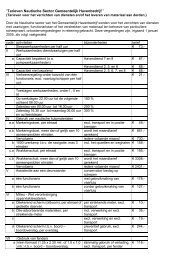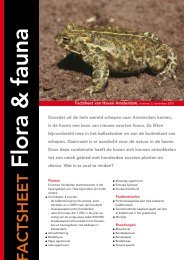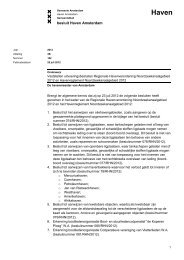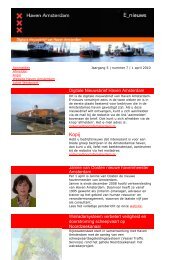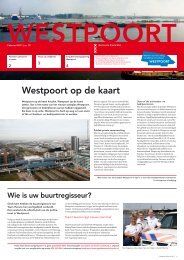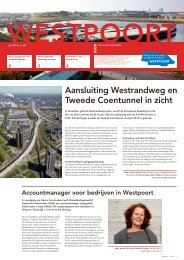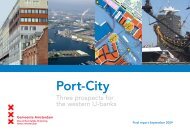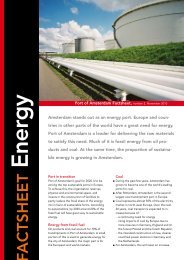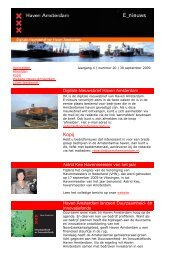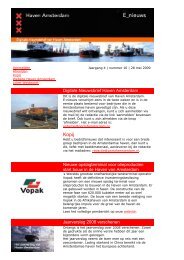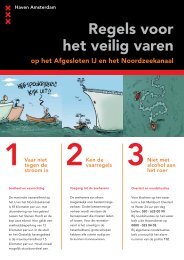You also want an ePaper? Increase the reach of your titles
YUMPU automatically turns print PDFs into web optimized ePapers that Google loves.
Sustainable port<br />
Among many other things, the Port of Amsterdam is creating an<br />
eco-friendly port by preventing the pollution of groundwater,<br />
surface water and the air; by cleaning or removing contaminated<br />
soil; as well as by creating natural areas in the port area.<br />
Soil<br />
Since 1985, responsibility for the soil quality lies with the tenant or<br />
user of the site. The condition of the soil is laid down in the lease when<br />
the contract actually takes effect. Should the soil be contaminated,<br />
the company concerned must arrange for the cleanup of the polluted<br />
soil or pay for the expenses. In <strong>2006</strong>, the Port of Amsterdam carried<br />
out soil surveys and cleanups at the site once used by the now<br />
defunct bitumen producer Smid & Hollander, as well as in Stadhaven<br />
Minerva.<br />
Water quality<br />
The Port Area is covered by the Surface Water Act. The Port of<br />
Amsterdam helps enforcement by carrying out inspections of<br />
illegal dumping and of pollution resulting from careless behavior or<br />
accidents. Water used by companies is removed using a separate<br />
sewage system and treated before its discharge into surface water.<br />
The Port of Amsterdam has developed a natural water-treatment<br />
system using helophyte filters (gravel-and-reed beds) to clean the<br />
rainwater coming from the company sites. In <strong>2006</strong>, a large helophyte<br />
filter was created in a wooded area called Geuzenbos, with the aim<br />
of treating the rainwater collected on the Westpoortweg (road).<br />
Mud on the bottom<br />
In dredging work, the port authority pays much attention to the<br />
mud on the bottom of the various water sections in the port. Clean<br />
dredged-up mud is used for other purposes, while slightly or heavily<br />
contaminated dredgings are removed and taken to well-protected<br />
and carefully monitored underwater storage facilities.<br />
Waste management<br />
The Port of Amsterdam ensures that companies active in the port<br />
dispose of their waste responsibly. The port authority has created<br />
sufficient waste-collection facilities for the ships; has set up a<br />
collective waste-collection service; and promotes recycling and<br />
otherwise re-using construction waste and demolition waste from<br />
the port.<br />
In <strong>2006</strong>, the port authority made it easier and cheaper for sea ships<br />
to dispose of maritime waste. The waste-disposal charges paid by<br />
all visiting ships went down. At the same time, ships bringing in<br />
waste received greater discounts on the fees paid for this service.<br />
Importantly, these fees now differentiate between the amounts of<br />
oil-containing waste and regular waste. The financial side of it all<br />
was streamlined. In <strong>2006</strong>, one third of the over 6,000 sea ships<br />
covered by the Port Waste Plan delivered waste to the official<br />
facilities in the ports on the North Sea Canal. The total amount was<br />
more than 45,000 cubic meters.<br />
Ecology<br />
The port area in Amsterdam includes many green areas, including<br />
tracts of land where no buildings or facilities may be constructed<br />
because of the presence of cables and pipelines. The Port of Amsterdam<br />
is now developing this green space in an ecologically responsible<br />
manner. Since the beginning of <strong>2006</strong>, companies wishing to cut down<br />
trees need to obtain a permit from the port authority, which carefully<br />
checks whether the request is reasonable and the trees can be replanted<br />
elsewhere or new trees can be planted in the port area to compensate<br />
for the loss of the removed specimens. In <strong>2006</strong>, companies felled<br />
222 trees (many of which were trees that had just “sprung up naturally”<br />
on unused company sites) and planted 40 new ones. To lure the<br />
protected Natterjack Toad away from places where companies<br />
may establish themselves in the future, the Port of Amsterdam<br />
created two toad pools – one near the Hornweg and one near the<br />
Petroleumhavenweg.<br />
1



